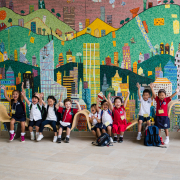
Interdisciplinary learning at HKIS
In collaboration with Hong Kong International School (HKIS)
At Hong Kong International School (HKIS), faculty from all grade levels are introducing interdisciplinary approaches to curriculum development. Interdisciplinary teaching and learning is exactly what it sounds like – combining learning from multiple disciplines to think about issues and solve problems. In comparison to traditional approaches, an interdisciplinary approach understands that problems may not fit into one subject and asks students to consider what knowledge and skills might help them find a solution. As in real life, that information is found in multiple subjects, whether it be scientific data, statistics, or novels as first hand accounts of what might be happening at a specific time and place.
Learning through experience

When students engage with their own environment, in real scenarios, they learn to think differently about their surroundings and in turn, they develop the skills to apply their knowledge to different contexts.
At HKIS, a choice-based curriculum is central to developing students’ understanding and applying it to real life situations. It is understood that students learn more deeply when they are in charge of their own learning. Choice is not just about what subjects you might choose to take. It is also about asking students: “What problem might you like to solve? How might you like to investigate it? What information might you need to find a solution, or to present your opinion?” Students are guided on this path by the school’s exceptional faculty in its state of the art campuses in the south of Hong Kong Island.
Learning in context: the power of place

At HKIS, the school’s location is its key asset in achieving its mission. HKIS’ location on Hong Kong Island – both Tai Tam and Repulse Bay – is its learning lab. Its campuses provide first hand opportunities for inquiry, right outside the front door. The faculty are introducing opportunities that will allow students to make sense of academic concepts in a real world context. For example, they might explore climate change through changes to the marine environment in Tai Tam Bay, from the perspective of social sciences, science and mathematics. They might document the impact of urbanization on communities, from the perspective of skills in English Language Arts, interviewing and synthesizing information, as well as the mathematical skills required for statistical analysis.
“Using a place-based interdisciplinary approach lets us embed students’ thinking and learning in the contexts in which they are already living,” says Fay Leong, the Director of Curriculum & Assessment at HKIS.
Learn more about HKIS’ interdisciplinary teaching and learning approach, and take a virtual tour of its beautiful campuses on its website.
Read more: Upper Primary Camp Week at HKIS is back – virtually




